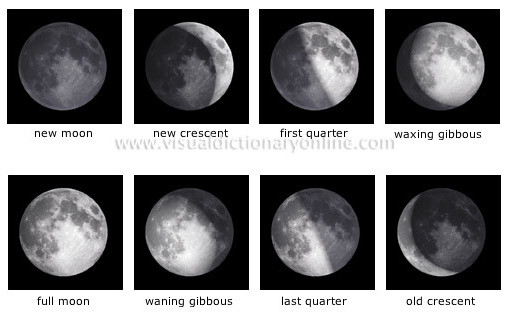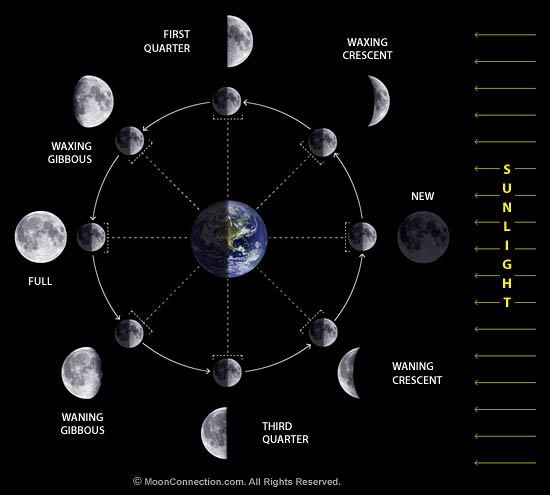What causes the phases of the moon?
595,988 Views
8,849 Questions Answered
Let’s Begin…
What causes the phases of the moon? The common incorrect answer is the shadow of the Earth. The phases of the moon are actually just a result of our perception of the moon's half-illuminated surface. When the moon does pass through Earth's shadow the result is a lunar eclipse. This can be spectacular as the moon turns a deep shade of red.
Additional Resources for you to Explore

The next image is from moonconnection.com, and it's a little more descriptive. The illustration may look a little complex at first, but it's easy to explain. Sunlight is shown coming in from the right. The earth, of course, is at the center of the diagram. The moon is shown at 8 key stages during its revolution around the earth. The moon phase name is shown alongside the image. The dotted line from the earth to the moon represents your line of sight when looking at the moon. The large moon image shows what you would see at that point in the cycle. For the waning gibbous, third quarter, and waning crescent phases you have to mentally turn yourself upside down when imagining the line of sight. When you do this, you'll "see" that the illuminated portion is on your left, just as you see in the large image. One important thing to notice is that exactly one half of the moon is always illuminated by the sun. Of course that is perfectly logical, but you need to visualize it in order to understand the phases. At certain times we see both the sunlit portion and the shadowed portion -- and that creates the various moon phase shapes we are all familiar with. Also note that the shadowed part of the moon is invisible to the naked eye; in the diagram above, it is only shown for clarification purposes. So the basic explanation is that the lunar phases are created by changing angles (relative positions) of the earth, the moon and the sun, as the moon orbits the earth.

The Babylonians developed a calendar based on the the moon and the sun cycles. The Lunar calendar was designed to work in conjunction with the solar cycle by adding leap months known an "intercalary" months.
Archeologists have discovered a lunar calendar in Aberdeenshire, Scotland. Their findings show that the calendar makers thought about time and figured out a means to follow it at a period in history that was still in the Stone Age. The discovery is considered both surprising and important because it now places a calendar nearly five thousand years before what was previously considered as the first formal calendar, created in Mesopotamia 5,000 years ago. But here, a discovery has been made of a calendar construct appearing to track the phases of the moon nearly 10,000 years ago.
In 2013, two holidays happen on the same day. Here's an article from The New York Times titled Holidays Holding Hands When Thanksgiving and Hanukkah Collide. Here's another fascinating article that explores this topic.
A lunar calendar is a calendar that is based on cycles of the lunar phase. Because there are about twelve lunations (synodic months) in a solar year, this period (354.37 days) is sometimes referred to as a lunar year.
Without a system of keeping track of time, it would be so easy to lose it -- to lose time that is. Here's a TED-Ed Lesson about how our perception of time can vary.
Where did time-telling come from? What are time zones and why are there so many of them? Get the answers to these questions and more in this journey through the history of time -- from sundials to hourglasses to modern clocks.
If you live in the United States, you may live in the Eastern Standard Time Zone. Or maybe you live in Mountain Standard Time or one of the other standardized time zones. But these time zones have not always been around. In fact, it's a fairly recent development. William Heuisler explains the history of time and how trains changed everything.
What if time didn't matter. What if you could travel backwards and forwards and through time -- time travel. Then, time wouldn't really matter, right? Or would it?
Also, I have often wondered why it's dark at night. I suppose, there are times when the moon just wouldn't look as beautiful unless it were set in a dark night sky. To learn why it's dark outside at night, check this out.
About TED-Ed Best of Web
TED-Ed Best of Web are exceptional, user-created lessons that are carefully selected by volunteer teachers and TED-Ed staff.
Meet The Creators
- Video created by Veritasium
- Lesson Plan created by Jordan Reeves



